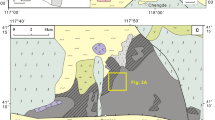Abstract
The layered intrusions in the Panzhihua-Xichang area may be grouped into two types: basic rock masses represented by the Panzhihua rockbody and basic-ultrabasic rock masses represented by the Hongge rockbody. Their major difference lies in that the former has poorly developed ultramafic facies, while the latter is characterized by well developed mafic facies and ultramafic facies. There exists apparent rhythmic stratification in the rock masses, which can be basically divided into four grades in terms of superimposition relationship and multicycle characters.
Both direct and indirect evidence suggest that the magma responsible for the layered intrusions in this area should be a transition-type alkaline olivine basalt magma derived directly from partial melting of the upper mantle. In rhythmic cycles of various grades, the magmatic evolution is characterized obviously by periodicity and early enrichment of Fe and Ti, which is evidently different from the evolution of the Skaergaard magma in which Fe and Ti are enriched at the late stage. The FCA diagram can be used to describe the unique evolutionary trend of magma in this area. It is demonstrated in this diagram that the enrichment of Fe and Ti is consistent with the increase of basicity.
In the upper magmatic chamber, the evolutionary trend of magma is conditioned by the difference in pressure, and this enables magma to form different types of rock assemblage. In the Fo-Di-An system, when the pressure exceeds 5 x 188 Pa, forsterite is incompatible with anorthite, and the rock facies sequence of Hongge type might form; when the pressure is lower than 5 x 108 Pa, forsterite can coexist with anorthite, and the rock facies sequence of Panzhihua type is likely to form if the magma is relatively rich in Mg and Fe components.
Similar content being viewed by others
References
Luo Yaonan, «Treatises on the Panzhihua-Xichang Rift System in China(l)», 1985, Geological Publishing House, Beijing, 1–25 (in Chinese).
Liu Di et al., «Treatises on the Panzhihua-Xichang Rift System in China(1)», 1985, Geological Publishing House, Beijing, 87–118 (in Chinese).
Feng Benzhi et al.,Bulletin of Changchun Geological College, 3 (1985), 108 (in Chinese).
Liu Ruoxin et al.,Geochimica, 2(1974), 78–92 (in Chinese).
Zhou Xingguo and Tang Xingxin, «Metallogenic Rule and Prediction of V-, Ti-magnetite Deposits in the Panzhihua-Xichang Region», 1985, Geological Publishing House, Beijing (in Chinese).
Lu Jiren,Bulletin of Institute of Geology and Ore Deposits under the Chinese Academy of Geological Sciences, 1(1982), 133–140(in Chinese).
Fodor, R.V. et al.,Contributions to Mineralogy and Petrology, 50, 3(1975), 173–195.
Morse, S. A. et al.,An J. Sci., 280 A, 1–2 (1980), 159–170.
Presnall et al.,Contributions to Mineralogy and Peatrology, 66, 2 (1978), 203–220.
Morse, S. A., «Basalte and Phase Diagrams», 1980, Springer-Verlag, 359.
Author information
Authors and Affiliations
Rights and permissions
About this article
Cite this article
Jiren, L., Guangdi, Z., Chengxin, Z. et al. Magma type and genesis of the basic-ultrabasic layered intrusions in Panzhihua-Xichang area, Southwest China. Chin. J. of Geochem. 7, 1–18 (1988). https://doi.org/10.1007/BF02840426
Issue Date:
DOI: https://doi.org/10.1007/BF02840426




